.
14.03.2016
Pluto’s ‘Snakeskin’ Terrain: Cradle of the Solar System?
-
Today’s blog post is from Orkan Umurhan, a mathematical physicist currently working as a senior post-doc at NASA Ames Research Center. He has been on the New Horizons Science Team for over two years. He specializes in astrophysical and geophysical fluid dynamics, and now works on a variety of geophysical problems, including landform evolution modeling as applied to the icy bodies of the solar system. He is a co-author of a graduate-level textbook on fluid dynamics coming out late this spring.
Greetings and salutations. In this week’s New Horizons blog entry, I want to share with you the exciting possibility that some of Pluto’s surface features may record conditions from the protosolar nebula from which the solar system formed.
A case in point is the image below. It’s what geologists call ‘bladed’ terrain in a region known as Tartarus Dorsa, located in the rough highlands on the eastern side of Tombaugh Regio. (Note that all names used here are informal.) A moment’s study reveals surface features that appear to be texturally ‘snakeskin’-like, owing to their north-south oriented scaly raised relief. A digital elevation model created by the New Horizons’ geology shows that these bladed structures have typical relief of about 550 yards (500 meters). Their relative spacing of about 3-5 kilometers makes them some of the steepest features seen on Pluto.
.
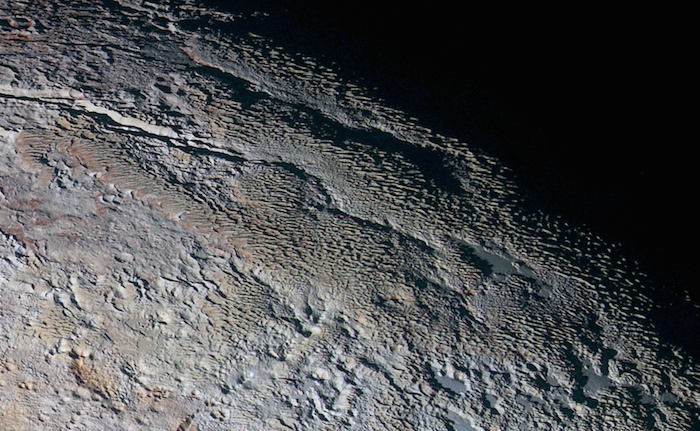
The Bladed Terrain of Tartarus Dorsa. Credits: NASA/JHUAPL/SwRI
Now, here comes the puzzle. Spectroscopic measurements of this region made by New Horizons’ Linear Etalon Imaging Spectral Array (LEISA) instrument show that this region of Pluto’s surface has a predominance of methane (CH4)—with a smattering of water as well. Naturally, one then would ask, “Can pure methane ice support such steep structures under Pluto’s gravity and surface temperature conditions over geologic time?”
The answer is a meek “maybe.” To date, there are only two known published studies examining the rheological properties (i.e., how much a material deforms when stresses are applied to it) of methane ice in the extreme temperature range of Pluto—a bitterly cold -300 to -400 degrees Fahrenheit. According to one study, the answer is a definite ‘no,’ because methane ice of those dimensions would flatten out in a matter of decades. Yet in another study, methane ice may maintain such a steepened structure if the individual CH4 ice grains constituting the collective ice are large enough. Which study is right? Or is there a way to reconcile them? This is something we simply do not know at the moment.
So before we try to explain how the bladed shapes came to be, we have to make sure we have developed a detailed and controlled laboratory understanding of the behavior of both pure methane ice and methane-hydrate ice. If there were ever an example of why we need further laboratory work, this is it!
But what if it turns out that pure methane ice is always too ‘mushy’ to support such observed structures? Because water is also observed in this region, perhaps the material making up the bladed terrain is a methane clathrate. A clathrate is a structure in which a primary molecular species (say water, or H2O) forms a crystalline ‘cage’ to contain a guest molecule (methane or CH4, for example.). Methane clathrates exist on the Earth, namely at the bottoms of the deep oceans where it is sufficiently cold to maintain clathrate ice. Under those terrestrial conditions, however, methane clathrates are relatively unstable to increases in temperature, causing their cages to open and release their guest methane molecules. This poses a real problem for terrestrial climate stability, since methane is a potent greenhouse gas.
However, under the cold conditions typical of the surface of Pluto, methane clathrates are very stable and extremely strong, so they might easily mechanically support the observed bladed structures. While there is no direct and unambiguous evidence of methane clathrates on the surface of Pluto, it’s certainly a plausible candidate, and we are actively considering that possibility too.
If the Tartarus Dorsa bladed region is comprised of methane clathrates, then the next question would be, “how were the clathrates placed there and where did they come from?” Recent detailed studies (see Mousis et al., 2015) strongly suggest that methane clathrates in the icy moons of the outer solar system and also in the Kuiper Belt were formed way back before the solar system formed – i.e., within the protosolar nebula – potentially making them probably some of the oldest materials in our solar system.
Might the material comprising the bladed terrain of Tartarus Dorsa be a record of a time before the solar system ever was? That would be something!
Quelle: NASA
.
Update: 17.03.2016
.
Science Papers Reveal New Aspects of Pluto and its Moons
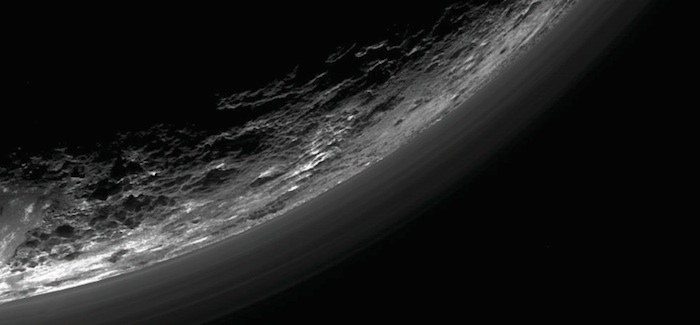
This image of haze layers above Pluto’s limb was taken by the Ralph/Multispectral Visible Imaging Camera (MVIC) on NASA’s New Horizons spacecraft. About 20 haze layers are seen; the layers have been found to typically extend horizontally over hundreds of kilometers, but are not strictly parallel to the surface. For example, scientists note a haze layer about 3 miles (5 kilometers) above the surface (lower left area of the image), which descends to the surface at the right.
Credits: NASA/JHUAPL/SwRI
-
A year ago, Pluto was just a bright speck in the cameras of NASA’s approaching New Horizons spacecraft, not much different than its appearances in telescopes since Clyde Tombaugh discovered the then-ninth planet in 1930.
But this week, in the journal Science, New Horizons scientists have authored the first comprehensive set of papers describing results from last summer’s Pluto system flyby. “These five detailed papers completely transform our view of Pluto – revealing the former ‘astronomer’s planet’ to be a real world with diverse and active geology, exotic surface chemistry, a complex atmosphere, puzzling interaction with the sun and an intriguing system of small moons,” said Alan Stern, New Horizons principal investigator from the Southwest Research Institute (SwRI), Boulder, Colorado.
.
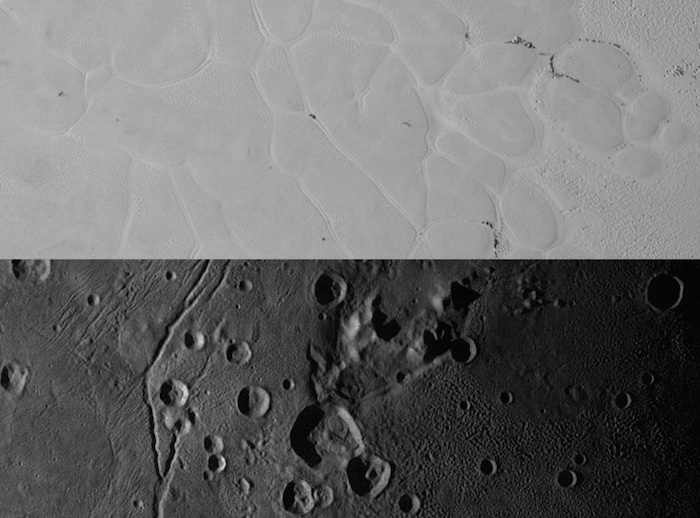
Above are New Horizons’ views of the informally named Sputnik Planum on Pluto (top) and the informally named Vulcan Planum on Charon (bottom). Both scale bars measure 20 miles (32 kilometers) long; illumination is from the left. The bright, nitrogen-ice plains are defined by a network of crisscrossing troughs. This observation was obtained by the Ralph/Multispectral Visible Imaging Camera (MVIC) at a resolution of 1,050 feet (320 meters) per pixel. The Vulcan Planum view in the bottom panel includes the “moated mountain” Clarke Mons just above the center of the image. The water ice-rich plains display a range of surface textures, from smooth and grooved at left, to pitted and hummocky at right. This observation was obtained by the Long Range Reconnaissance Imager (LORRI) at a resolution of 525 feet (160 meters) per pixel.
Credits: NASA/JHUAPL/SwRI
-
After a 9.5-year, 3-billion-mile journey – launching faster and traveling farther than any spacecraft to reach its primary target – New Horizons zipped by Pluto on July 14, 2015. New Horizons’ seven science instruments collected about 50 gigabits of data on the spacecraft’s digital recorders, most of it coming over nine busy days surrounding the encounter.
The first close-up pictures revealed a large heart-shaped feature carved into Pluto’s surface, telling scientists that this “new” type of planetary world – the largest, brightest and first-explored in the mysterious, distant “third zone” of our solar system known as the Kuiper Belt – would be even more interesting and puzzling than models predicted.
The newly published Science papers bear that out; click here for a list of top results.
“Observing Pluto and Charon up close has caused us to completely reassess thinking on what sort of geological activity can be sustained on isolated planetary bodies in this distant region of the solar system, worlds that formerly had been thought to be relics little changed since the Kuiper Belt’s formation,” said Jeff Moore, lead author of the geology paper from NASA's Ames Research Center, Moffett Field, California.
Scientists studying Pluto’s composition say the diversity of its landscape stems from eons of interaction between highly volatile and mobile methane, nitrogen and carbon monoxide ices with inert and sturdy water ice. “We see variations in the distribution of Pluto's volatile ices that point to fascinating cycles of evaporation and condensation,” said Will Grundy of the Lowell Observatory, Flagstaff, Arizona, lead author of the composition paper. “These cycles are a lot richer than those on Earth, where there's really only one material that condenses and evaporates – water. On Pluto, there are at least three materials, and while they interact in ways we don't yet fully understand, we definitely see their effects all across Pluto's surface.”
.
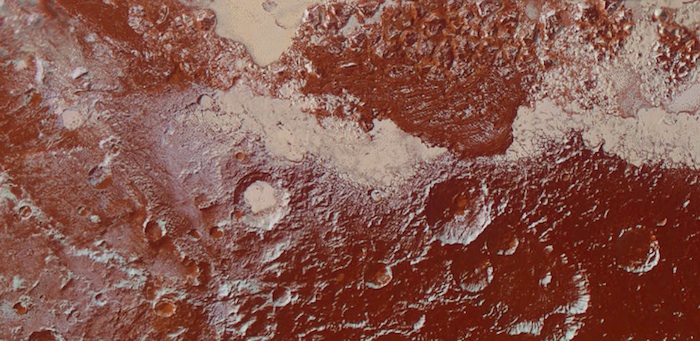
This enhanced color view of Pluto's surface diversity was created by merging Ralph/Multispectral Visible Imaging Camera (MVIC) color imagery (650 meters or 2,132 feet per pixel) with Long Range Reconnaissance Imager panchromatic imagery (230 meters or 755 feet per pixel). At lower right, ancient, heavily cratered terrain is coated with dark, reddish tholins. At upper right, volatile ices filling the informally named Sputnik Planum have modified the surface, creating a chaos-like array of blocky mountains. Volatile ice also occupies a few nearby deep craters, and in some areas the volatile ice is pocked with arrays of small sublimation pits. At left, and across the bottom of the scene, gray-white methane ice deposits modify tectonic ridges, the rims of craters, and north-facing slopes. The scene in this image is 260 miles (420 kilometers) wide and 140 miles (225 kilometers) from top to bottom; north is to the upper left.
Credits: NASA/JHUAPL/SwRI
-
Above the surface, scientists discovered Pluto’s atmosphere contains layered hazes, and is both cooler and more compact than expected. This affects how Pluto’s upper atmosphere is lost to space, and how it interacts with the stream of charged particles from the sun known as the solar wind. “We’ve discovered that pre-New Horizons estimates wildly overestimated the loss of material from Pluto’s atmosphere,” said Fran Bagenal, from the University of Colorado, Boulder, and lead author of the particles and plasma paper. “The thought was that Pluto’s atmosphere was escaping like a comet, but it is actually escaping at a rate much more like Earth’s atmosphere.”
SwRI’s Randy Gladstone of San Antonio is the lead author of the Science paper on atmospheric findings. He added, “We’ve also discovered that methane, rather than nitrogen, is Pluto’s primary escaping gas. This is pretty surprising, since near Pluto’s surface the atmosphere is more than 99 percent nitrogen.”
Scientists also are analyzing the first close-up images of Pluto’s small moons—Styx, Nix, Kerberos and Hydra. Discovered between 2005 and 2012, the four moons range in diameter from about 25 miles (40 kilometers) for Nix and Hydra to about six miles (10 kilometers) for Styx and Kerberos. Mission scientists further observed that the small satellites have highly anomalous rotation rates and uniformly unusual pole orientations, as well as icy surfaces with brightness and colors distinctly different from those of Pluto and Charon.
They’ve found evidence that some of the moons resulted from mergers of even smaller bodies, and that their surface ages date back at least 4 billion years. “These latter two results reinforce the hypothesis that the small moons formed in the aftermath of a collision that produced the Pluto-Charon binary system,” said Hal Weaver, New Horizons project scientist from the Johns Hopkins University Applied Physics Laboratory in Laurel, Maryland, and lead author of the Science paper on Pluto’s small moons.
About half of New Horizons’ flyby data has now been transmitted home – from distances where radio signals at light speed need nearly five hours to reach Earth – with all of it expected back by the end of 2016.
“This is why we explore,” said Curt Niebur, New Horizons program scientist at NASA Headquarters in Washington. “The many discoveries from New Horizons represent the best of humankind and inspire us to continue the journey of exploration to the solar system and beyond.”
Quelle: NASA
-
Update: 22.03.2016
.
Pluto may have hosted lakes and rivers of liquid nitrogen
Liquid nitrogen may once have flowed on the surface of Pluto – and could exist in pockets beneath the ice we see today. That’s the latest finding from the New Horizons probe, which is now nearly 300 million kilometres past the dwarf planet, but still beaming data back to Earth.
The discovery comes from using data from New Horizons to model how Pluto’s climate and atmospheric pressure have changed over time. These models point to periods in Pluto’s history where the temperature and pressure are high enough for frozen nitrogen ice on the surface to melt.
“Liquids may have existed on the surface of Pluto in the past,” said mission leader Alan Stern at a press conference today at the Lunar and Planetary Science Conference in The Woodlands, Texas.
If correct, this could explain features seen on the surface, including extended networks of terrain that could have been carved by rivers and bodies of still liquid (see image, right). “We see what for all the world looks to a lot of our team like a former lake,” said Stern.
New Horizons captured images of a lake-like feature on Pluto
“It’s very smooth, as if a liquid has frozen across one height,” he told New Scientist. “It’s hard to come up with an alternate model that would explain that morphology.”
The team came to this conclusions after combining the detailed topographic map of Pluto’s surface gathered by New Horizons with models of its climate zones.
On Earth, climate zones are the result of the 23 degree tilt of our planet’s axis relative to the sun. The tropics is the warm region where the sun always passes directly overheard, and is confined near the equator. But Pluto, never one to conform, has a 120 degree tilt, spreading its tropics wide. “Most of Pluto is tropical,” said New Horizons team member Richard Binzel of the Massachusetts Institute of Technology.
Arctic tropics
But that doesn’t mean it isn’t chilly. On Earth, the arctic zones are the smaller regions at each pole that experience prolonged periods of light and darkness. On oddball Pluto, these artic zones extend much further down, actually crossing into the tropics – meaning some regions are both tropical and arctic. “There is no analogue to that here on Earth,” said Binzel.
The team studied how these zones have changed over time, and how they might evolve in the future, as a result of Pluto’s tilt changing. For example, 800,000 years ago the dwarf planet would have experienced a climate extreme as its axis reached 103 degrees. The tropics extended to near the poles, while the arctic reached down near the equator. This could explain the dark region seen around Pluto’s equator – it is the only region that is always tropical, and never arctic, meaning ice doesn’t build up there.
At this point in the past, the atmospheric pressure could have been just a tenth of Earth’s at sea level – higher than that seen on Mars. “This really changes your view of this little planet and how it operates,” said Stern. The increased pressure would allow liquid nitrogen to pool on the surface, meaning a New Horizons mission launched around that time would have seen a much wetter Pluto.
But New Horizons could still see liquid on Pluto today, if indirectly. The team is still developing models of the nitrogen ice glacial flows the probe spotted, but early indications suggest the crushing weight of ice could create the pressure conditions necessary for a liquid layer.
“You could have a liquid state at the base,” says Orkan Umurhan of NASA’s Ames Research Center in California. In the past, this could have been 100 metres below the surface, but in the present day it would have to be 1 kilometre deep.
Our limited understanding of the extreme behaviour of nitrogen is actually hindering the team’s analysis, says Umurhan. “Those experiments haven’t been done yet in the laboratory.”
Quelle: NS
-
Update: 25.03.2016
.
See NASA’s New Photo of a Frozen ‘Lake’ on Pluto
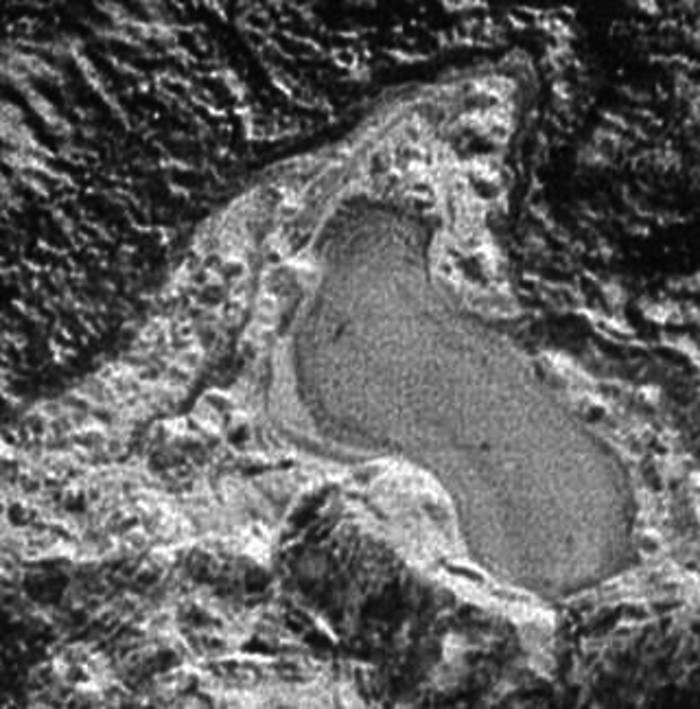
It appears to be a frozen former lake of liquid nitrogen
Millions or billions of years ago, liquids might have pooled on the surface of Pluto, a new photograph captured by NASA’s New Horizons spacecraft shows.
The image, captured by the spacecraft on July 14 and published by NASA on Thursday, appears to show a frozen former lake of liquid nitrogen situated in a mountain range, NASA said in a post about the photo. The lake is as much as 20 miles wide at one point.
“In addition to this possible former lake, we also see evidence of channels that may also have carried liquids in Pluto’s past,” said Alan Stern, principal investigator of New Horizons, in a post published by NASA.
Quelle: TIME
-
Update: 2.04.2016
.
Pluto's Bladed Terrain in 3-D
One of the strangest landforms spotted by NASA's New Horizons spacecraft when it flew past Pluto last July was the "bladed" terrain just east of Tombaugh Regio, the informal name given to Pluto's large heart-shaped surface feature.
No geology degree is necessary to see why the terrain is so interesting – just a pair of 3-D glasses will do. The blades are the dominant feature of a broad area informally named Tartarus Dorsa. They align from north to south, reach hundreds of feet high and are typically spaced a few miles apart. This remarkable landform, unlike any other seen in our solar system, is perched on a much broader set of rounded ridges that are separated by flat valley floors.
On the global image, the bladed terrain extends far to the east. New Horizons scientists have speculated about (but not yet agreed on) the terrain's origins. Current theories include erosion from evaporating ices or deposition of methane ices; New Horizons researcher Orkan Umurhan takes an in-depth look at the terrain – and proposes another origin idea – in this recent NASA Web blog. (link to https://blogs.nasa.gov/pluto/2016/03/11/plutos-snakeskin-terrain-cradle-of-the-solar-system/)
The amazing stereo view combines two images from the Ralph/Multispectral Visible Imaging Camera (MVIC) taken about 14 minutes apart on July 14, 2015. The first was taken when New Horizons was 16,000 miles (25,000 kilometers) away from Pluto, the second when the spacecraft was 10,000 miles (about 17,000 kilometers) away. Best resolution is approximately 1,000 feet (310 meters).
.
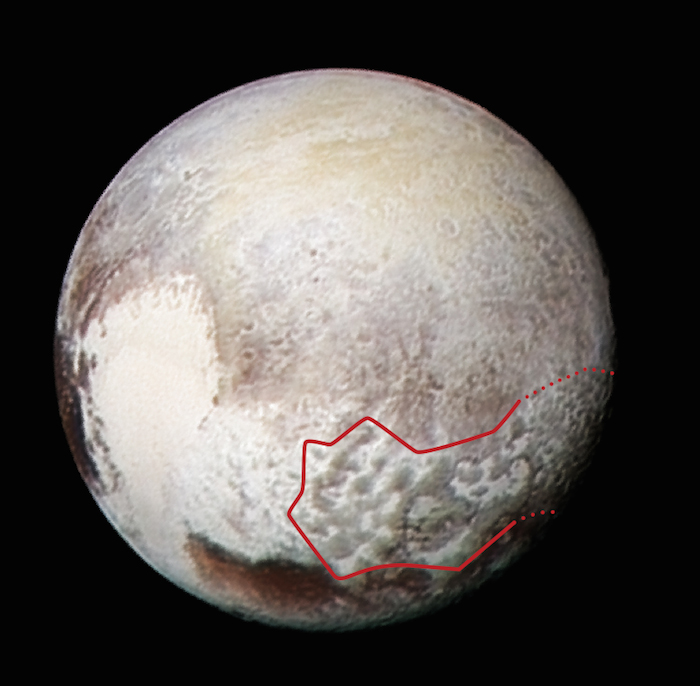
'Blades' Across Pluto: This global view of Pluto combines a Ralph/Multispectral Visible Imaging Camera (MVIC) color scan and an image from the Long Range Reconnaissance Imager (LORRI), both obtained on July 13, 2015 – the day before New Horizons' closest approach. The MVIC scan was taken from a range of 1 million miles (1.6 million kilometers), at a resolution of 20 miles (32 kilometers) per pixel. The corresponding LORRI image was obtained from roughly the same range, but has a higher spatial resolution of 5 miles (8 kilometers) per pixel. The red outline marks the large area of mysterious, bladed terrain extending from the eastern section of the large feature informally named Tombaugh Regio.
Image credit: NASA/Johns Hopkins University Applied Physics Laboratory/Southwest Research Institute
.
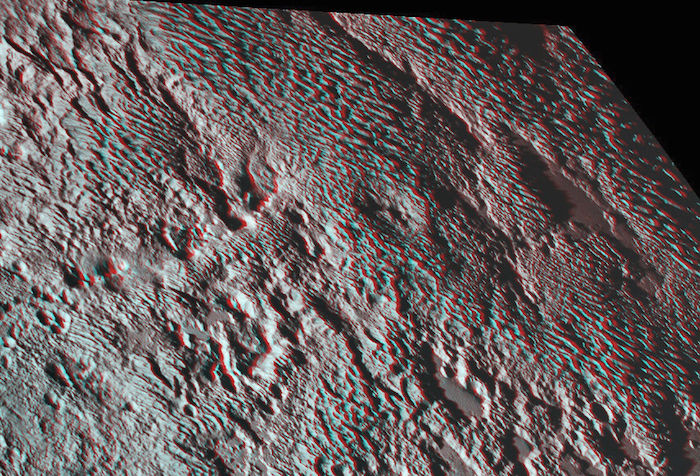
Pluto's Bladed Terrain in 3-D
Release Date: March 31, 2016
Keywords: LORRI, MVIC, Pluto, Ralph
One of the strangest landforms spotted by NASA's New Horizons spacecraft when it flew past Pluto last July was the "bladed" terrain just east of Tombaugh Regio, the informal name given to Pluto's large heart-shaped surface feature.
The blades are the dominant feature of a broad area informally named Tartarus Dorsa. They align from north to south, reach hundreds of feet high and are typically spaced a few miles apart. This remarkable landform, unlike any other seen in our solar system, is perched on a much broader set of rounded ridges that are separated by flat valley floors.
This amazing stereo view combines two images from the Ralph/Multispectral Visible Imaging Camera (MVIC) taken about 14 minutes apart on July 14, 2015. The first was taken when New Horizons was 16,000 miles (25,000 kilometers) away from Pluto, the second when the spacecraft was 10,000 miles (about 17,000 kilometers) away. Best resolution is approximately 1,000 feet (310 meters).
Quelle: NASA
-
Update: 6.04.2016
.
Multitasking New Horizons observed solar wind changes on journey to Pluto
SWAP data show that the tumultuous flow of solar particles becomes more uniform by the time the solar wind reaches Pluto
-
San Antonio — April 5, 2016 — In addition to its history-making encounter with Pluto last July, the New Horizons spacecraft also recorded significant changes in how the solar wind behaves far from the Sun.
The Solar Wind Around Pluto (SWAP) instrument, operated by Southwest Research Institute (SwRI), collected three years’ worth of measurements before the July 15 Pluto flyby. Data showed that the tumultuous flow of solar particles, which in the inner solar system is structured by the interaction of fast and slow flows as well as eruptive events on the Sun, becomes more uniform by the time the solar wind has traversed the 3 billion miles to Pluto’s orbit.
SWAP measures the solar wind and ions created as the neutral interstellar material becomes ionized and is “picked up” by the solar wind. These interstellar pickup ions can have up to twice the speed and four times the energy of the solar wind. Farther out in space, these ions may be the seeds of the extremely fast energetic particles called anomalous cosmic rays, which pose a radiation threat to astronauts closer to Earth. These ions also play an important role in shaping the boundary where the solar wind hits interstellar space. New Horizons is currently at about 35 astronomical units (about 35 times farther than the Earth to the Sun). It is the only operating spacecraft in the outer solar system. Only Voyager 2 has measured the solar wind farther away from the Sun; however, SWAP on New Horizons will be the first to measure the interstellar pickup ions in the outer solar system.
The results will appear in a study to be published April 6 by the Astrophysical Journal Supplement.
Lead author Dr. Heather Elliott, a principal scientist in SwRI’s Space Science and Engineering Division, said the SWAP instrument was busy even when the rest of New Horizon’s instruments were “hibernating” to save energy on the long, nine-year voyage to Pluto.
“The instrument was only scheduled to power on for annual checkouts after the Jupiter flyby in 2007,” she said. “We came up with a plan to keep the particle instruments on during the cruise phase while the rest of the spacecraft was hibernating. We started observing in 2012.”
The plan yielded three years of near-continuous observations, capturing detailed measurements of the space environment in a region few spacecraft have ever visited.
Because the Sun is the source of the solar wind, events on the Sun are the primary force that shapes the space environment. Shocks in the solar wind — which can produce space weather, such as auroras, on worlds with magnetic fields — are created either by fast, dense clouds of material called coronal mass ejections or by the collision of two different-speed solar wind streams. These individual features are easily observed in the inner solar system, but New Horizons didn’t see the same level of detail.
“At this distance, the scale size of discernible solar wind structures increases, since smaller structures are worn down or merge together,” said Elliott. “It’s hard to predict if the interaction between smaller structures will create a bigger structure, or if they will flatten out completely.”
Subtler signs of the Sun’s influence are also harder to spot in the outer solar system. Characteristics of the solar wind — speed, density, and temperature — are shaped by the region of the Sun it flows from. As the Sun and its different wind-producing regions rotate, patterns form. New Horizons didn’t see patterns as defined as they are when closer to the Sun, but it nevertheless did spot some structure.
“Differences in speed and density average together as the solar wind moves out,” said Elliott. “But the wind is still being heated as it travels and faster wind runs into slower wind, so you see evidence of the Sun’s rotation pattern in the temperatures even in the outer solar system.”
New Horizons is the first mission in NASA’s New Frontiers program, managed by the agency’s Marshall Space Flight Center in Huntsville, Ala. The Johns Hopkins University Applied Physics Laboratory designed, built, and operates the New Horizons spacecraft and manages the mission under Principal Investigator Dr. Alan Stern’s direction for NASA’s Science Mission Directorate. SwRI leads the science mission, payload operations, and encounter science planning. The NASA Heliophysics program also supported the analysis of these observations.
Quelle: Southwest Research Institute
5336 Views
